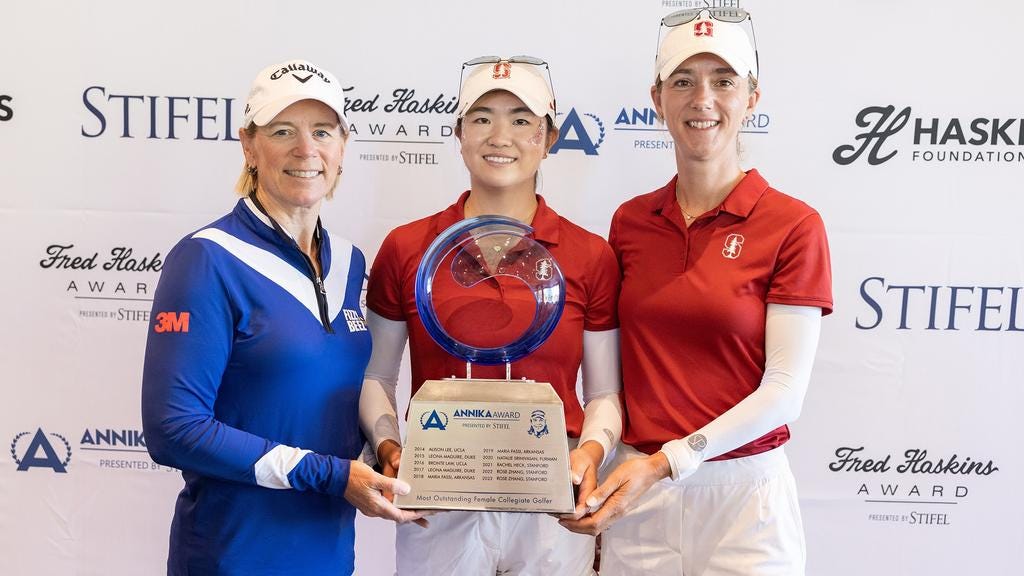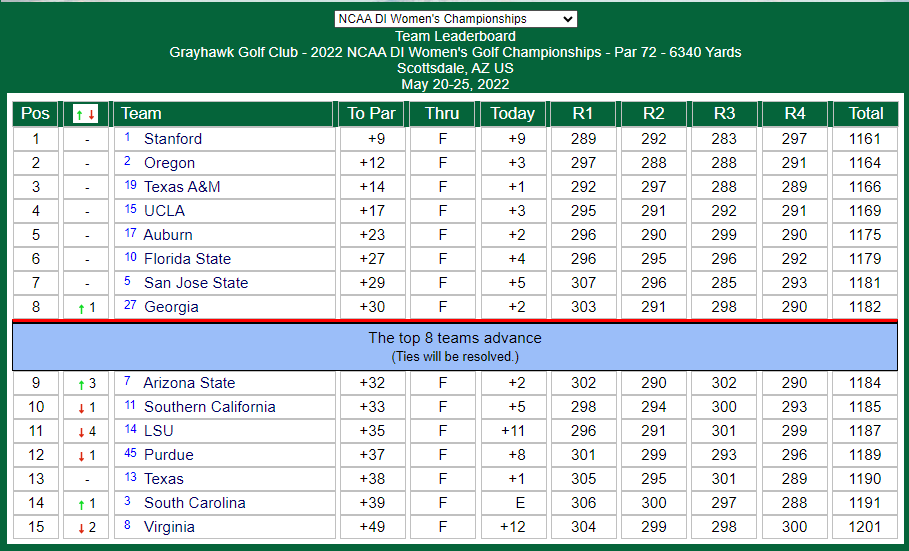This is part of a series on the Women’s Collegiate Championships
The championships held at Grayhawk from 2021-23 were historic for a number of reasons. It was the first time since the 1950s (pre-NCAA) that the women’s championship was held at the same golf course three years in a row. The 2021 championship was especially meaningful as a return from the first absence the tournament had suffered since World War II. By the end of that run, one particular Rose had bloomed in full and captured the attention of the entire golf world. Not to be lost in the middle was one of those rare times when lofty expectations were met, and not even a curse could cage the Cardinal.
*NOTE: underlined text provides a link to references or sites with more information
RETURNING FROM COVID
The 2019-2020 season was going incredibly well until suddenly it wasn’t. Unlike every other season for the last 74 years, this year ended without a national champion. The whole world had come to a screeching halt as the coronavirus pandemic swept across the globe, disrupting every normal activity imaginable and sending everyone home to hunker down and wait to see what happened. Once the first major sport decided to cancel its season, everyone else soon followed suit, fearing backlash from not deciding quick enough to release their “...in these unprecedented times” email in the interest of public safety. College golf teams that were just gearing up for the Spring sprint towards the championship were shut down, in some cases pulled out of the middle of a tournament so they could be rushed back to home/school/wherever they could quarantine. The end to the season was jarring in a way that this author can’t effectively describe. Teams like Texas - recognized in the final WGCA Coaches Poll as the top team in the nation - went from enjoying the second act of their own sports movie to having the projector turned off, the house lights forcefully brightened, and unceremoniously booted off the property. You don’t have to go home but you can’t stay in public.
THE 2021 CHAMPIONSHIP
March 2021 not only marked the one year anniversary of the moment everything shut down, it also was the unofficial start of the 2020-2021 season for many teams. For a sport that is traditionally split between the Fall and Spring, the quick ramp up from starting at the usual halfway point was as difficult as it was unusual for the “modern” college golfer. The landscape of women’s college golf, like so many other things, had shifted so much in the last 12 months that nobody really knew what to expect. For Stanford, it started out with a bang as they won their first tournament, setting team scoring records as freshman Rachel Heck won her very first college tournament. A few weeks later, Heck set the school 54-hole record with her 16-under 200 score to win the Fresno State Classic. Moving quickly, the next two tournaments for Stanford were the Pac-12 and Regional Championships, both of which were won by the freshman phenom who had quickly helped propel the Cardinals to the top of the national rankings.
The Grayhawk Golf Club, home course for Arizona State, was set to host its first of three straight women’s (and men’s) championships in 2020, but the pandemic set that back by a year. There’s undoubtedly a joke in there somewhere about Heck and the desert heat, but that feels disrespectful towards the tremendous play by the Stanford sensation who opened with 69-67 for a 5 stroke lead at the halfway point. Stanford’s 4 stroke lead through 36 holes quickly quintupled by the end of the third round as they shot a school NCAA championship scoring record 277/-11. Ironically, that third round was the one where Heck broke her streak of 12 straight rounds shooting in the 60s, but she still stood atop the individual leaderboard with a 5 stroke lead over teammate Angelina Ye. Twenty-four hours later, Heck holed her 280th stroke to become Stanford’s first female golf champion as the team cruised into the #1 seed for match play.
Part of the appeal of match play as a championship format is that it’s not only exciting to watch, it truly is a great equalizer. Stanford had taken the #1 seed by 13 strokes, and yet that gave them no advantage against the #8 seed Arizona Wildcats. Angelina Ye’s match against Gile Bite Starkute was the first out on the course for the two schools, but was the last one to finish, going to a playoff to decide which team would advance to the semifinals. After Ye’s 40-foot birdie putt missed on the 19th hole, Starkute drilled her 15-footer. The cat had caught the bird and preserved the curse against #1 seeds.
Six years after the #4 seed Stanford captured the school’s first NCAA women’s golf team championship, Ole Miss did the same thing from the same seeded position. Not only was it the Rebel’s first title in women’s or men’s golf, and the first women’s title in any sport, it was the first championship for the school since the football program’s 1962 title! Perhaps 1st Team All-American Julia Johnson said it best:
"I can't even describe it," said Johnson. "I don't know. I mean, no one ever thought that we could do this. No one ever really believed in us, and I knew. I just knew when I committed here that we could do this and I just believed in us from the start. It's just really special. I'm just really thankful for this moment."
THE HYPE
Returning all five of their starters that had blitzed the (stroke play) competition the previous year, Stanford was guaranteed to be the favorites coming into the 2021-22 season. There was one factor, however, that elevated the hype for the Cardinals into the stratosphere - the addition of Rose Zhang. Joining the 2020 British Women’s Amateur Champ, Aline Krauter, was the 2020 US Women’s Amateur and 2021 US Girl’s Junior Amateur champ - the first player to win those two prestigious events in that order - who was now the #1 amateur player in the world according to WAGR.
Stanford played four tournaments in the Fall portion of their season, and came away with four team trophies. Rose played in the first three events - missing the final tournament in Hawaii as she and teammates Heck, Sturdza, and Becht were all competing in the Spirit International - and racked up three individual wins. Not only did her third (consecutive!) victory put her in rarified air, Rose matched Heck’s record 16-under-par score from last year with a remarkable 197 at Stanford’s home tournament. Rachel got in on the fun at the next tournament, winning the Lamkin Invitational for her 7th career victory (in only 350 days!) as Rose fell all the way to...T4. Rose finished runner-up to Rachel in the next tournament as Heck defended her Gunrock Invitational title (site of her first collegiate tournament & victory) in what was a record setting day all around. Not only did Heck set the new school record with her 198/-18, Stanford broke the NCAA scoring record with an incredible 50-under-par 814! Rose, Rachel, and the Stanford team didn’t win either of the remaining two regular season events, but it didn’t matter - the hype by this point was out of control.
After both the team collectively and Rose individually finished runner-up in both the Pac-12 and Regional championships, a new type of golf media company called No Laying Up posted their one-hour feature on the Cardinal team that had captured the attention of the entire golf world.
THE TOURNAMENT [May 20-25 , 2022]
For the second year in a row Arizona State hosted the women’s (and men’s) championship at Grayhawk Golf Club. Many of the participants were repeat visitors, allowing coaches and many players the advantage of knowing what to expect for both course conditions and even some pin placements. No matter how prepared you think you are for desert golf, however, the heat can always sneak up on you and cause havoc. Spectators and tv viewers alike were eagerly showing up in higher numbers than ever before, anticipating more match play drama. They would not be disappointed.
STROKE PLAY
The wind tested players early on, gusting up to 30 miles an hour at points during the first round. It calmed down during the second round, but players were challenged by the difficult pin placements that resulted in many high numbers on the scorecard. Scoring was back down in the third round as teams finally saw some red figures, but still only two teams were under par on the day. The field was cut to the top 15 teams and top remaining individuals before the start of the fourth round, but the pace was still fairly slow as players fought heat, fatigue, and unbelievable pressure in the final round of stroke play. Predictably, scores were high but by the end of the day spirits were even higher for players on 8 teams and one national champion.
INDIVIDUAL RESULTS
Rose Zhang, dubbed “freshman phenom” and every other positive superlative imaginable, took her expected place atop the individual leaderboard with a first round 68 (-4) and never let it go. Through 54 holes her lead had grown to 7 strokes as she sat as one of only four players under par, finishing the day with three straight birdies. The only real sign of anything resembling trouble came with a double-bogey on the front 9 of her final round, but even finishing 3-over-par for the day (75) didn’t lose much ground to the field. Finishing at 282 (-6), Zhang was still one of only four players under par for the tournament. She became the second Stanford Cardinal freshman to claim the individual NCAA championship in as many years, cementing an historic legacy in less than a dozen collegiate tournaments.
TEAM RESULTS
The wind was a challenge, but the Cardinals knew how to fly in that wind and sat atop the leaderboard after 18 holes. They were still there after 36 holes, but nearly everyone had been shaken up in some way by the difficult pins on day two. Stanford capitalized on day three when the scores came down for the first time, and stretched their lead to 9 strokes over Oregon, the 2nd ranked team in the country. The Ducks took back 6 of those strokes in the final round, but at the end of 72 holes the Cardinals still nested on top of the rest. The match play seeding was largely set after the third round, but Georgia managed to sneak into the top 8 to claim the last seed, just ahead of host Arizona State. This gave the Bulldogs first crack at fulfilling the curse that had prevented #1 seeds from winning any of the women’s championship since the beginning of match play in 2015. One other constant in the seven championships since then - remember, no championship in 2020 - was Stanford being the only team to make the match play portion each time. No matter the result, there was guaranteed to be drama.
MATCH PLAY
One of the things critics point at most when it comes to disparaging the match play format is the fact that it’s not uncommon for highly ranked teams to meet in early matches. The #2 ranked Oregon vs #5 ranked San Jose State match could have easily been a thrilling Finals title fight, but instead it was “merely” a Quarterfinals morning bout. The Ducks prevailed, winning 4 matches to 1, in a match much closer than the scores indicated. Texas A&M was the second highest ranked team to make match play, but they showed why they earned the #3 seed in prevailing over #10 ranked (and #6 seeded) FSU; the deciding point coming from the thrilling match between Cernousek [A&M] and Wallin [FSU] that was decided in extra holes. The Auburn/UCLA match was as close as their year long rankings indicated it would likely be, yet none of the three closing Auburn players saw the 18th hole. Georgia was on top early in their David-vs-Goliath match against Stanford, and it looked for a time like the #1 seed curse was going to strike again early this year. The Cardinals battled, however, and Brooke Seay was able to flip her match to get the third point needed to go along with wins from Heck and Krauter. Zhang showed signs that she may be susceptible to pressure after all as her match officially went down as a loss (after Stanford got the 3rd point needed to claim victory) despite having an eagle putt on the 18th green to possibly send it to extra holes.
Oregon rolled through another match play opponent in the afternoon Semifinals, this time against Texas A&M. Two of the Ducks took early leads to make the end result nearly a foregone conclusion in those matches as the two teams made the turn. Even still, A&M battled hard and it still took until the 16th and 17th hole before anything was decided. In the end, Hsin-Yu (Cynthia) Lu, the Pac-12 individual champ, closed out her match and send the Ducks to the championship finals for the first time in program history. Stanford didn’t exactly roll through their matches against Auburn, but it also never really felt in doubt. The US Am and British Am winners showed off their match play experience and Seay was able to capture the decisive third point with a birdie putt on the 18th hole. It was an exclamation point at the end of a very long day.
Sometimes, even with match play, you get exactly the championship matchup you hope for. #1 Stanford vs #2 Oregon was (objectively) the match most believed would determine a national champion, and the two teams did not disappoint. Oregon had won the first Pac-12 title in program history by 7 strokes over Stanford (and rival Oregon State) a month before, and had followed that victory with another in the Albuquerque Regional - another program first - at another “desert course” (albeit with much wider fairways). It’s safe to say that the Ducks were not afraid of anyone, and yet they didn’t get off the ground as fast as the nimble Cardinal. As the first match made the turn, the Ducks were down in 3 matches and tied in the other two. Oregon senior Tze-Han (Heather) Lin gained the lead in her match against Rachel Heck before they reached the turn, and managed to get a crucial point for the Ducks. Unfortunately for the Oregon faithful, there would only be one other yellow highlight on the GolfStat leaderboard by the end of the match. Stanford’s Brooke Seay and Aline Krauter were the first two on the course for Stanford and both wrapped up their matches on the 15th green. The next two matches went Oregon’s way with Chacon stealing a much needed second point from Engelmann on the 18th hole. Fittingly, it all came down to Rose in the anchor match against Nielsen. She did not disappoint. Two days after winning the individual title, Zhang calmly rolled in a par putt on the 17th green to clinch the team title. As if this movie could have ended any other way.
The #1 team with the #1 player managed to secure both of the titles and effectively sweep the championship awards. Stanford had stood tall amidst the weight of unbelievable expectations, and somehow managed to meet (exceed?!) their own lofty expectations.
ROSE MAKES MORE HISTORY IN 2023
Rose Zhang could have gone on the play pro golf as soon as possible after her incredible 2021-22 collegiate season and nobody would have batted an eye. Instead she returned to Stanford for the 2022-23 season and, impossibly, improved her already unbelievable legacy. Not only did she win practically everything in college golf, she added the Augusta National Women’s Amateur trophy to complete what some called the US women’s amateur grand slam - US Girl’s Junior Am, US Women’s Am, NCAA championship, and ANWA. As the season drew to a close, there was still one more individual historic milestone Rose could reach that would put her in the exclusive club of 1 in the record book.

THE 2023 CHAMPIONSHIP
At the 54-hole cut to 15 teams in the 2023 NCAA championship, Stanford was in familiar territory atop the team leaderboard. Rose, on the other hand, was sitting tied with three other players 4 strokes back of the leader, Catherine Park [USC]. It would take a great round to push for an individual title, and that’s exactly what Rose had in her. With a bogey-free final round 68 (-4), Rose Zhang became the first woman to repeat as an individual champion, not just in the history of the NCAA but also in the lengthy history of women’s collegiate golf.
Stanford once again secured the #1 seed at the end of stroke play, but the curse that they avoided last year proved too strong to overcome a second time. Stanford suffered a shocking defeat (can you call it a true upset from the 9th ranked team in the country?) at the hands of USC in the semifinal round. Ultimately it was Wake Forest lifting the NCAA team championship trophy for the first time in program history. It had been a long and exciting path to the championship for the #2 ranked team in the country - and #3 seeded team in match play - but the Demon Deacons led by Coach Kim Lewellen had been up to the challenge and were rewarded for an incredible season.
SURPASSING TIGER’S STANFORD RECORD
Throughout her collegiate career, Rose Zhang was linked to Tiger Woods. The comparison was obvious given their connection to the Stanford golf program, but also for their dominance in just the two years they played college golf. They didn’t win everything, but the aura around them was so potent and captivating that they were both anointed living legends while still on campus. But Rose achieved things that Tiger didn’t and made history in ways he wasn’t able to. We wrote about an interesting discrepancy with the number of wins Tiger actually had while at Stanford, but nonetheless Rose is the undisputed record holder with her 12 collegiate wins in only 20 tournaments (60% winning percentage!!). Also, her two individual NCAA titles gives her the edge over Tiger’s in 1996. It will be a long time before their pro careers can be adequately compared, but Rose, like a young Tiger three decades before her, has already obtained rare status with her collegiate play and will forever be a college golf hero.
Thanks for reading!
Up Next:
That concludes our Women’s Championship Series! We hope you enjoyed reading as much as we did researching and writing. More college golf history will arrive in your inbox soon!












